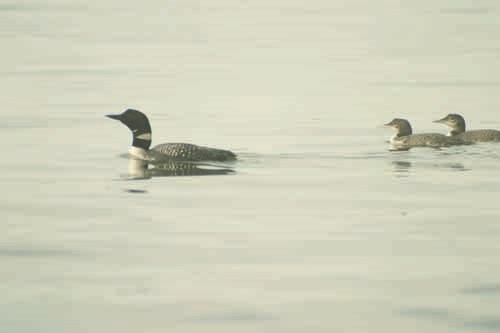The loons of Madge Lake appear to have had a good year rearing young.
At least that is the findings of this doing counts on the lake, said Rob Wilson, a member of Yellowhead Flyway Birding Trail Association who has been part of annual counts on the lake since 2004.
Wilson said the local association has been counting loons as part of the Canadian Lakes Loon Survey under the auspices of Bird Surveys Canada. He said they chose to study Madge Lake in Duck Mountain Provincial Park because it has a nesting population of common loons.
The loons are counted by observation three times a year, beginning in June to establish how many mated pairs are on the lake.
"Loons are very, very territorial," said Wilson. "They'll defend that territory quite rigorously from other loons." He added pairs also " tend to return year-after-year if they've been successful."The second count is in early July to ascertain the number of chicks born.
"Chicks tend to hatch out from the second week of June up until the first week of July," said Wilson, so "we go out to try to determine how many chicks there are."
The final count is in late August to count juveniles, those loons which have survived from the time they were chicks.
"The adults abandon the young in late August," said Wilson, noting the older birds migrate south, while the young stay on the lake until they grow their first set of flight feathers, and then they fly south.
In terms of the 2010 count, numbers were very encouraging, although Wilson admitted "we didn't get as good a data for all counts as we would have liked We weren't really certain of the chick count."
However, Wilson said with the help of Bob and Margaret Graham, Barb Elsasser, Diane Norman and others, they estimated 14, or 15 chicks "which is the highest we've ever had. It's almost double what we've been seeing."
Wilson said the high chick numbers was surprising since there were high water levels at Madge Lake this year. He said loons "nest very close to the edge," of the water, and he feared the high water might flood some nests.
The chicks also appear to have had a good year.
"We only got out one day this fall, but we think there were 13 juveniles produced that will survive long enough to make the migration."
Wilson said he believes the strong numbers are a reflection that lake users at Madge Lake are watching out for the birds more.
"We're feeling people at Madge are becoming aware of what we're doing," he said, adding that seems to be translating into more respect for the birds in terms of not water skiing, or doing other activities in loon nesting areas which would disturb the birds.
"We want to make it a loon friendly lake," said Wilson, adding that appears to be happening.




